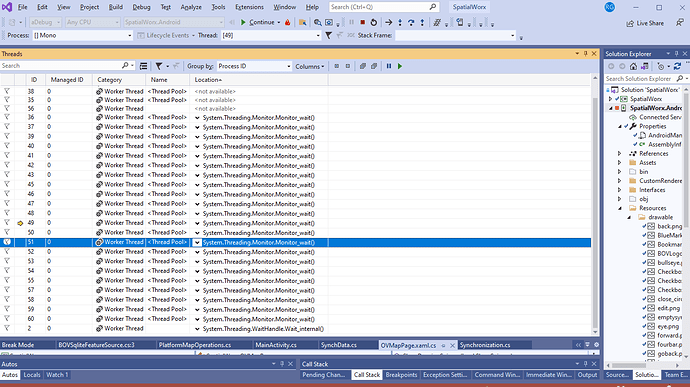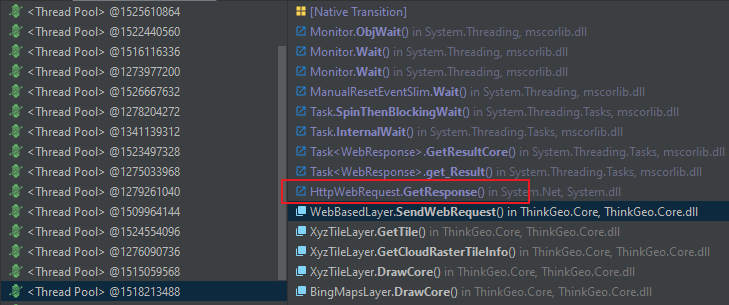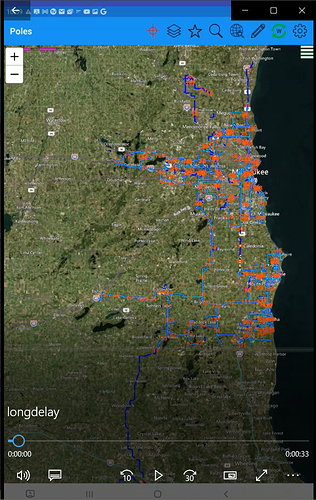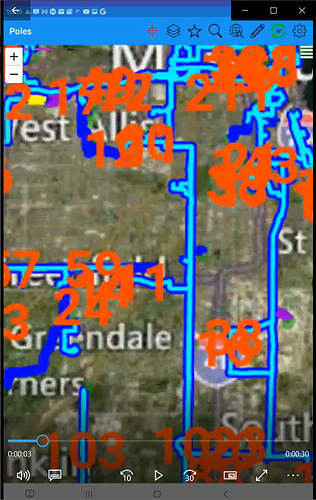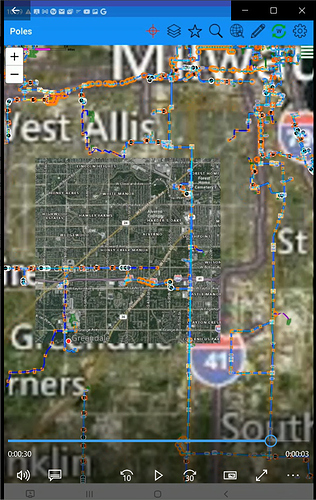Using Thinkgeo.core 13.0.0-beta341 and Thinkgeo.ui.android 13.0.0-beta302
A good portion of the time the maps are very responsive – however every now and then there is an excessively long wait for anything to be drawn to the screen. Somewhere in the 5-15 second time frame. This gives the user the impression that the application is hung. I have not received any complaints about v10 behaving in this fashion
This is a very sporadic problem – but happens more frequently when other layers are added beyond the bingMapsOverlay. I have duplicated this in the HowDoISample project using the BingMapOverlay selection.
The maps do eventually get drawn-- and all of the tiles are displayed so it’s not timing out. The way that I reproduced this is to rapidly pan/zoom in/zoom out. Exact steps are hard to identify – however I believe that zooming in/out is where this is happening most of the time.
This is the stack at the time that we see this long delay – this stack is from the HowDoISample and is similar to the stack we are receiving in our code when this happens.
0xFFFFFFFFFFFFFFFF in System.Threading.Monitor.Monitor_wait C#
0x31 in System.Threading.Monitor.ObjWait at /Users/builder/jenkins/workspace/archive-mono/2020-02/android/release/mcs/class/corlib/System.Threading/Monitor.cs:85,5 C#
0x11 in System.Threading.Monitor.Wait at /Users/builder/jenkins/workspace/archive-mono/2020-02/android/release/mcs/class/referencesource/mscorlib/system/threading/monitor.cs:218,13 C#
0x3 in System.Threading.Monitor.Wait at /Users/builder/jenkins/workspace/archive-mono/2020-02/android/release/mcs/class/referencesource/mscorlib/system/threading/monitor.cs:228,13 C#
0x109 in System.Threading.ManualResetEventSlim.Wait at /Users/builder/jenkins/workspace/archive-mono/2020-02/android/release/external/corert/src/System.Private.CoreLib/shared/System/Threading/ManualResetEventSlim.cs:607,33 C#
0x30 in System.Threading.Tasks.Task.SpinThenBlockingWait at /Users/builder/jenkins/workspace/archive-mono/2020-02/android/release/external/corert/src/System.Private.CoreLib/src/System/Threading/Tasks/Task.cs:2892,25 C#
0x6C in System.Threading.Tasks.Task.InternalWait at /Users/builder/jenkins/workspace/archive-mono/2020-02/android/release/external/corert/src/System.Private.CoreLib/src/System/Threading/Tasks/Task.cs:2832,21 C#
0x13 in System.Threading.Tasks.Task<System.Net.WebResponse>.GetResultCore at /Users/builder/jenkins/workspace/archive-mono/2020-02/android/release/external/corert/src/System.Private.CoreLib/src/System/Threading/Tasks/Future.cs:490,31 C#
0x11 in System.Threading.Tasks.Task<System.Net.WebResponse>.get_Result at /Users/builder/jenkins/workspace/archive-mono/2020-02/android/release/external/corert/src/System.Private.CoreLib/src/System/Threading/Tasks/Future.cs:466,19 C#
0x6 in System.Net.HttpWebRequest.GetResponse at /Users/builder/jenkins/workspace/archive-mono/2020-02/android/release/mcs/class/System/System.Net/HttpWebRequest.cs:1216,5 C#
0x3C in ThinkGeo.Core.WebBasedLayer.xh8= C#
0x2F in ThinkGeo.Core.XyzTileLayer.yB8= C#
0x68 in ThinkGeo.Core.XyzTileLayer.yR8= C#
0x324 in ThinkGeo.Core.XyzTileLayer.DrawCore C#
0x1D in ThinkGeo.Core.BingMapsLayer.DrawCore C#
0x2F4 in ThinkGeo.Core.Layer.ux8= C#
0xA8 in ThinkGeo.Core.Layer.Draw C#
0x27 in ThinkGeo.UI.Android.LayerTileView. C#
0x10 in System.Threading.Tasks.Task.InnerInvoke at /Users/builder/jenkins/workspace/archive-mono/2020-02/android/release/external/corert/src/System.Private.CoreLib/src/System/Threading/Tasks/Task.cs:2476,17 C#
0x1 in System.Threading.Tasks.Task.Execute at /Users/builder/jenkins/workspace/archive-mono/2020-02/android/release/external/corert/src/System.Private.CoreLib/src/System/Threading/Tasks/Task.cs:2319,17 C#
0x6 in System.Threading.Tasks.Task.ExecutionContextCallback at /Users/builder/jenkins/workspace/archive-mono/2020-02/android/release/external/corert/src/System.Private.CoreLib/src/System/Threading/Tasks/Task.cs:2463,13 C#
0x73 in System.Threading.ExecutionContext.RunInternal at /Users/builder/jenkins/workspace/archive-mono/2020-02/android/release/mcs/class/referencesource/mscorlib/system/threading/executioncontext.cs:968,17 C#
0x4 in System.Threading.ExecutionContext.Run at /Users/builder/jenkins/workspace/archive-mono/2020-02/android/release/mcs/class/referencesource/mscorlib/system/threading/executioncontext.cs:910,13 C#
0x38 in System.Threading.Tasks.Task.ExecuteWithThreadLocal at /Users/builder/jenkins/workspace/archive-mono/2020-02/android/release/mcs/class/corlib/corert/Task.cs:72,6 C#
0x50 in System.Threading.Tasks.Task.ExecuteEntry at /Users/builder/jenkins/workspace/archive-mono/2020-02/android/release/external/corert/src/System.Private.CoreLib/src/System/Threading/Tasks/Task.cs:2385,17 C#
0x2 in System.Threading.Tasks.Task.System.Threading.IThreadPoolWorkItem.ExecuteWorkItem at /Users/builder/jenkins/workspace/archive-mono/2020-02/android/release/external/corert/src/System.Private.CoreLib/src/System/Threading/Tasks/Task.cs:2334,13 C#
0x75 in System.Threading.ThreadPoolWorkQueue.Dispatch at /Users/builder/jenkins/workspace/archive-mono/2020-02/android/release/mcs/class/referencesource/mscorlib/system/threading/threadpool.cs:899,29 C#
0x0 in System.Threading._ThreadPoolWaitCallback.PerformWaitCallback at /Users/builder/jenkins/workspace/archive-mono/2020-02/android/release/mcs/class/referencesource/mscorlib/system/threading/threadpool.cs:1261,13 C#

